
By Ken Jakalski
Tony Holler and I had a recent discussion regarding the training devices we’ve purchased and used over the years that turned out to be, as Chief Dan George might say, “a road that leads nowhere.”
Tony describes his ventures as the “follies of his past.” I like that description. There are probably many things that we’ve tried and then abandoned for various reasons.
That discussion got me thinking about an article highlighting a few specific things coaches might wish to consider before investing in any training device.

Cost Benefit
Is the device cost effective relative to my budget, and can I justify its expense were I to get the necessary funding for the device? Booster Clubs will often try to fulfil a coach’s request, but the question that members will most frequently ask is: how many athletes will actually use the device, and how often will they use it?

Knowledge
Do I have a sufficient knowledge base to successfully implement the device or explain why it is essential for my program? It’s not enough to say a particular high school uses the device, and they won a state championship. Those willing to fund a training device are not interested in testimonials or anecdotes. They want to know if I’ve done my homework. Do I fully understand what the device is intended to do, and can I justify its expense?

Potential for Injury
Is it possible that using the device could end up doing more harm than good? The coach who developed the training device clearly had a specific concept in mind, but is the final product safe to use? Could an athlete be seriously injured using the product–not just through either the coach’s or athlete’s negligence–but because of a flaw in either the concept or design of the product? As I weigh risk to reward, is it clear that the benefit of the device far outweighs any possible risks assumed in choosing to use it?

Workflow Efficiency
Is it something I can use with a larger number of athletes within the time constraints of a typical practice? In other words, how many of the training devices will I need? Might a limited number of these devises create a workflow issue? Might I be wasting limited training time because not all athletes will have access to the device or equipment at the same time? There may be things worse than having a group of sprinters standing around waiting to use the device, but I agree with Brooks Johnson about sprinters being immediate gratification athletes.

Assessment
Do I have methods of assessment in place to indicate that the device is indeed a key factor in any speed improvement? Of course, I can say that sprinters have improved their times, but can I directly attribute the gains to the training the athletes have done using that device? Might those gains just be a matter of applying a novel stimulus that allowed the athletes the opportunity to restore and recover?
So let’s begin down the road that for me led nowhere.
If you don’t know where you are going, every road will get you nowhere. — Henry A. Kissinger
Parachutes
I began using parachutes twenty three years ago.
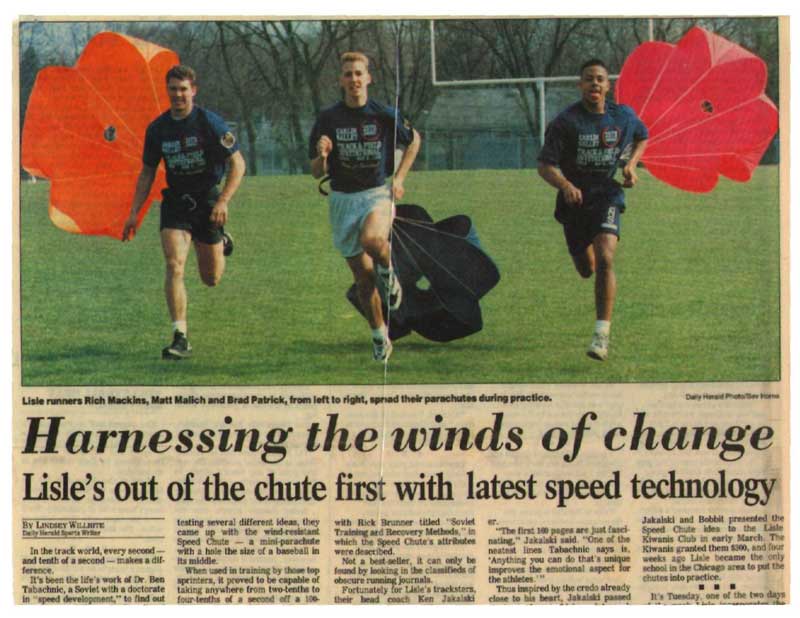
Figure 1: Speed Parachutes
They were the chutes first introduced by Ben Tabachnik and purchased through Atletika. As I noted in my Track Technique article from 1998, “test results, apparently performed in a secluded stadium outside of Moscow, proved that the speed chute was superior to all other devices designed to improve maximal speed, start acceleration, and speed-endurance. Tabachnik notes a dramatic reduction of 0.2 to 0.4 seconds in 100 meter dash times.” I stopped using the chutes after one season. Which of my criteria questions was I not able to answer?
- Did I know why I was using them? Was I really improving acceleration? What mechanics was changing while running with the chutes? Were these changes beneficial? As athletes ran faster, the chute increased resistance. Was this desirable?
- Were the chutes safe? Well, they easily tangled, and three of them ripped in the first two sessions because they got caught on either a fence or hurdle. And what about runners who might experience a cross wind? Could a strong crosswind alter the chute’s direction, resulting in sheering forces at the sprinter’s knee?
- I had a limited number of chutes in various sizes (different resistances). Were all my sprinters able to use the chutes at the same time? Which ones would get the bigger chutes?
- How was I assessing the chute training sessions? Quite simply, I wasn’t. I had no idea how much resistance the chutes were applying to various sprinters, or to what extent changes in wind could affect any data were I to time various repetitions. And the chutes, as you can see from the image, were unstable. Could the flapping or position influence the times I recorded?
Overspeed Tubing
I began overspeed training— surgical tubing that came with plastic connectors under the product name SST–even before parachutes.
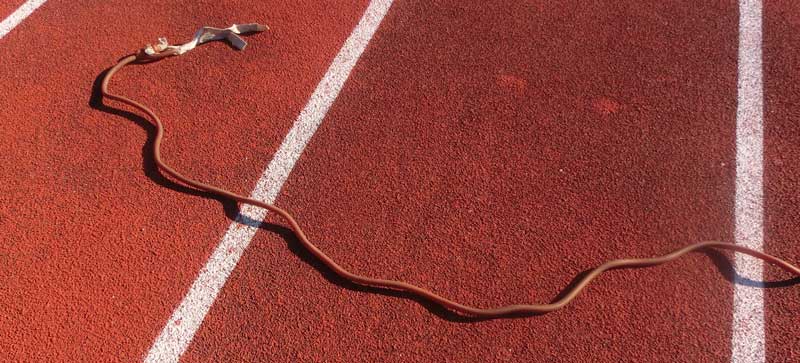
Figure 2: SST Surgical Tubing
- Did I know why I was using lengths of tubing extended 2 ½ times its length? Was I really improving speed via “overspeed”? Was mechanics changing positively through their use?
- Was the tubing safe? I had no idea how long the rubber would last before it had the potential to snap if continually stretched, or even if it was indeed safe (just because 2 ½ its length was recommended) to repeatedly extend the hose lengths. The tubing was tied to the plastic connectors attached to the belt harness.
- Could these come undone over repeated training bouts? What happens if the athlete holding one end of the tubing were to let go? I was concerned that the harness was attached by belt above the sprinter’s crotch, and as the tubing returned to its natural length, sprinters had to step carefully to avoid tripping over the relaxed hose. This certainly was altering mechanics.
- Could a larger number of sprinters use the SST cables? With one cable, one sprinter holds the line while the other walks back extending the tubing to the recommended length. One section of tubing could accommodate two athletes, so several sections of tubing could be an effective for a group of sprinters.
- How was I assessing overspeed via the tubing? I wasn’t. Was I filming athletes to see what was changing relative to where and how they were landing? I wasn’t. So, why was I using surgical tubing as a training device?
Ultra Speed Pacer
The Ultra Speed Pacer was the “next generation” of overspeed training. It was an ingenious application of the “block and tackle” concept whereby the sprinter is pulled along at a 2 to 1 ratio to the outgoing harnessed runner’s speed.
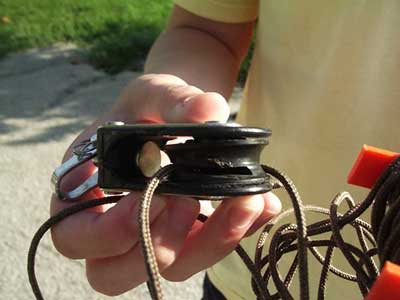
Figure 3: Friction burns a hole in the Ultra Speed Pacer
- Did I know why I was using the device? Yes. I believed it was safer than surgical tubing. The speed was controllable in a sense that the outgoing runner’s speed determined the speed of the sprinter being towed, and if the towed sprinter thought he was losing control, he or she could slap away the cord from the harness.
- Was the device really safe? It involved the kind of technology one could find in any hardware store: two pulleys, a plastic extension line reel, and 300 feet of smaller gauge nylon cord. And therein lay the problem. Were the pulleys designed to stand up to repeated bouts of sprinters traveling at eight to nine meters per second? The one I used couldn’t. The wheel of the pulley was plastic. During a session, it appears as if the bearings in the pulley seized up, which meant that the cord was still being pulled “over” the wheel…until the friction of the cord heated up the plastic to the point that it actually burned through the wheel.
- Could a large number of sprinters use the Ultra Speed Pacer? It was effective in that two sprinters were engaged with each unit. One was accelerating while the other was being towed. The problem was that the end of the Pacer cord had to be connected to either a fence or post, and this could result in multiple Pacers in use at the same time requiring suitable anchoring points that could get in the way of other runners on the track.
- How was I assessing the Ultra Speed Pacer? At the time, most sprint coaches were noting that assisted sprinting should not exceed 10%, the point being that if a sprinter were towed beyond the 10% window, he or she would begin to initiate braking actions to avoid falling, and because these actions result in increased ground contact time, they would be inhibiting correct maximum velocity mechanics. However, I never timed these sessions, and was never sure exactly how fast any of my sprinters were running, or for how many meters they were sustaining faster speeds.
Kolka Thigh Trainers
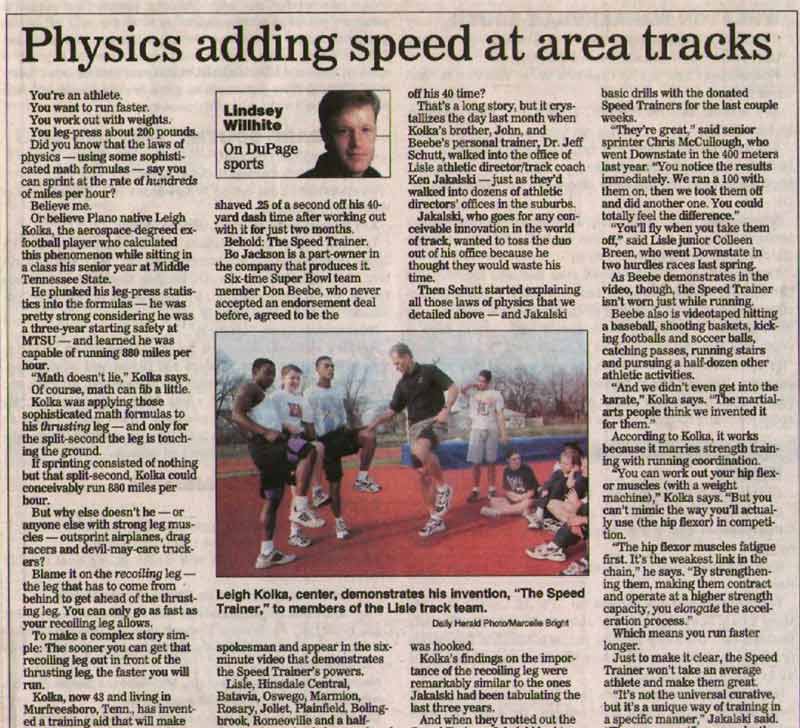
Figure 4: Kolka Speed Trainers
Speed Trainers are Velcro thigh wraps with pockets for placing up to three pounds per wrap. This was the invention of the late Leigh Kolka.
- Why did I begin using these? I had found some corroborative research indicate the importance of hip flexor strength for sprinting. I believed the added weight via a thigh wrap was a simple way of increasing leg swing resistance.
- Was the device safe? The Speed Trainers wrapped tightly around the thigh and were additionally supported by a waist belt. The weights themselves fit snugly into the neoprene pockets.
- Could a large number of athletes use the Speed Trainers? Yes. At one point, I had ten pair of trainers and could order more had I needed them. These stored easily and didn’t take long for the sprinters to put on. We did have some minor issues with slippage, and sprinters would often have to re-tighten wraps between repetitions.
- How was I assessing the Speed Trainers? The trainers were intended to improve the speed at which the limb could be positioned, but as per the findings of JAP2000, if the maximum speed at which limbs can be repositioned appears not to be a trainable entity (at least implicitly from the analysis of fast and slow runners in the study), then the I didn’t have a complete grasp of what sprinting in these resistance cuffs was achieving. The Harvard researchers whom I had asked for feedback believed that the weights would probably increase the support forces at a given speed, but would not alter ground support forces at higher speeds. A sprinter would just not be able to run as fast, and at slower speeds the ground forces would be lower. Indeed, this is exactly what I observed a few years later via OptoJump technology.
Bullet Belts
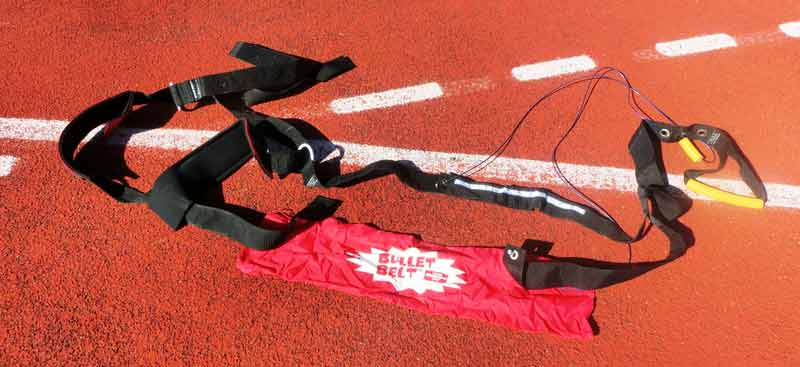
Figure 5: Bullet Belt
The Bullet Build was the clever invention of Lane Gainer. Many still use the devices and are satisfied with the product and the results. My original model had a solidly designed waist belt, an eighteen inch Velcro tail, and a 48 inch release handle with a special rip-release cable.
- Why did I begin using these? The concept made great sense. My concern with resistance devices prior to the Bullet Belt was that the possible disruption of a smooth pattern of acceleration might offset any “advantage” the device offered. The Bullet Belt could vary the resistance simply by changing how much of the Velcro the straps were attached to.
- Was the Bullet Belt safe? Yes. The belt was well designed, and the explanations for implementing them in training were very clear.
- Could a large number of athletes use the Bullet Belts? Yes. Two sprinters could work with one belt—one controlling the belt while the other begins to accelerate against the resistance. For a larger number of sprinters, more Bullet Belts would be needed.
- How was I assessing the Bullet Belt resistance runs? This was an issue for me. The resistance only lasts for as long the straps are joined to the Velcro. Might the best benefit of the Bullet Belt be in starting and block clearance? Perhaps, but as Ralph Mann noted, “At the end of the push phase for both the rear foot and front foot, the knee is not fully extended. This indicates that the athlete is not pushing the leg through full extension.” He concludes by noting that the “actively pulling the foot off the blocks prior to full knee extension is critical for the success of the start.” In the regard, I agree that this correct action may best be mimicked and developed in the weight room via “full squats that stop at an upper angle of around 315 degrees and a lower angle of around 90 degrees, and half squats that stop at an upper angle of approximately 270 degrees and a lower leg angle of 135 degrees.”
Dorsiflexors
The dorsiflexor was an offshoot of the Speed Dynamics videos of the mid-eighties. At least two such devices were designed to accustom the sprinter to holding his or her foot in a dorsiflexed position. The intention was for athletes to go about regular training wearing these “dorsi-flexors.” At least two types of these could be purchased from Track and Field supply companies.

Figure 6: Williams DorsiFlexor
I never purchased or used either of these, and that may have been because of my second criterion. Were these safe? Forcing the foot into a more-or-less locked anatomical position just didn’t seem to be a very practical thing to do, especially if we were missing something critical about what is occurring on the ground once an athlete is up to speed. The great Willie Williams, legendary sprint coach at the University of Illinois, even developed his version of this dorsiflexor.
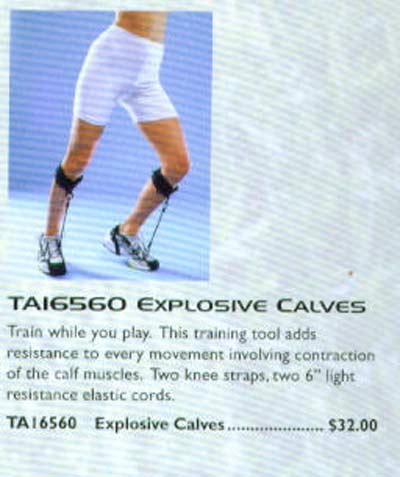
Figure 7: Dorsiflexor
Willie, who 10.1 for 100 yards on a dirt and cinder track back in 1950, and then ran 10.1 for 100 meters in breaking Jesse Owen’s twenty year old world record six year later, never heard of the significance of dorsiflexion, and never trained with his foot in that mechanical position.
Nevertheless, he was convinced that this mechanics intervention influenced both the speed of the swinging limb as well as braking forces on landing. What was my assessment that suggested this might not be a beneficial device? I had no evidence via video analysis or OptoJump that proper execution of this mechanical position was resulting in either shorter contact times or larger vertical forces.
I have no issues with coaches who find these any of these devices to be beneficial in improving the ability of their sprinters to achieve faster speeds. What I know is that fast limb velocity into the ground, along with stiff ground contact, will result in fast running speeds and large forces. I’m just not certain these devices were, at least from my perspective, helping to achieve these ends.
I won’t deny that I’ve been influenced by the observations of the late Mel Siff, who once noted the following:
One is made to feel ill-equipped and ill-educated if you do not implement detailed programs using multiple isolated tools like balance balls, wobble boards, foam rollers, special treadmills, special shoes, as many Pilates contraptions as possible, plyometric balls, boxes, exercise and plyo sleds, gym machines, underwater jogging devices, dorsiflexor devices, ‘bodyblades’, grip strengtheners, rebounders, plyo hurdles, plyometric benches and so and so forth.
In the sport specific setting, the athlete generally wants to devote most time to the sport itself, not to numerous time consuming supplementary activities -so why devote 15-20 minutes of a session to playing around with balancing toys, intricate technical procedures, and a functionally integrated series of multi-dimensional holistic exercised, when an entire workout with free weights could be done in not much more time than that?
In all six examples, each device fit the first criterion. The devices were all affordable. What is clear is that the most practical expenditure for me should have been assessment equipment–either timing or video—that would have given me a better idea of what exactly was happening as my sprinters were being resisted or assisted. Over the past twelve years, I’ve invested in virtually no training devices other than a slide box for pole vaulters. But I have invested heavily in timing and assessment equipment such as LYNX Reactime, SiliconCoach, OptoJump, and, yes, I now have twelve Freelap watches and eight transmitters!
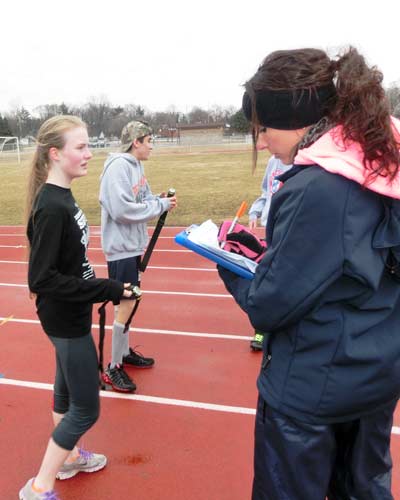
Figure 8: Coach Mullin records the Freelap splits.
Please share this article so others may benefit.
[mashshare]


Where can I buy SPRINT-ASSISTED DEVICES: SURGICAL TUBING?
It’s a fact that gymnasts are the strongest athletes. The reason why is because they are constantly doing full body weight exercises. I can see how they develop really lean mass. I noticed that a lot of speed training equipment uses some body weight training. perhaps that’s why they work really well.
I’m glad you mention how it’s important to know how to successfully implement the device and understand why you use it. This would probably help you use the device in the most efficient way possible so that you can increase your speed. If you don’t understand how to implement it, working with a professional would probably help ensure that the training is as effective as possible.